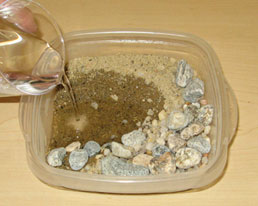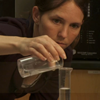1. Water, a Liquid

Our fifth grade story begins with students learning that a major body of water - an inland sea - has evaporated, leaving a fleet of ships resting on dry ground. Does evaporation really happen at that scale? What becomes of all that water? To launch an investigation of water and its transformations, pairs of students use sand, gravel, small stones, and water to build miniature lakes in plastic sandwich boxes. Students observe, modify, and weigh these "mini-lakes" across the curriculum unit. They measure the weight and volume of the lake materials, compare the heaviness for size of water to sand, and determine that each cubic centimeter of water weighs one gram.
All the materials in the mini-lake have weight and take up space, and thus are forms of matter. Does a single drop of water also have weight? While the weight of a drop does not register on the classroom scales, students use their knowledge of the unit weight of water to help them calculate the weight of a single drop. That weight is tiny, but the weight of a bucket of water is significant. How many drops must it take to give a bucket-full its weight? And how many grains of sand combine to give a bucket-full its significant weight? These rhetorical questions, and experiences that follow in later strands, help set the stage for understanding that objects are composed of unimaginable quantities of extremely tiny particles.
Weight becomes an important tool when measuring matter that is invisible. For example, when a weighed quantity of salt is dissolved in water, it disappears. The particles become so small, and so spread apart, we can no longer see them. Does that salt still exist? Its presence can be confirmed because its weight is conserved in the solution.
Investigations:
- Investigation 1: Why are these ships in a field?
- Investigation 2: How can we keep track of our mini-lake materials?
- Investigation 3: How does water compare with sand?
- Investigation 4: What does a drop of water weigh?
- Investigation 5: What changes and what stays the same when salt dissolves in water?
The Child and the Scientist

The Child: What makes the particulate model of matter so challenging for students?

The Scientist:
What are materials made of?
Letters from the Engineer
While students use science practices to deepen their understanding of scientific ideas throughout this curriculum, some of their investigations bridge to the engineering world. To highlight some of the instances where students engage in an engineering practice or gain insight into the engineer’s world, the curriculum includes Letters from the Engineer. Look for these letters (in the special boxes) and read them to the class.





